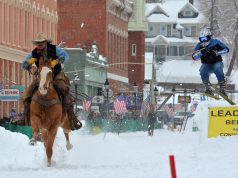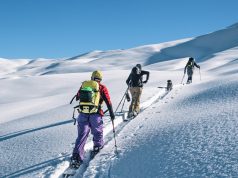
The mountain is nothing.
Well, it is something — a mass of rock and ice with scattered alder bushes and some evergreens. But the small sub-peak is dwarfed by its Alaskan neighbors. It seems a strange place for a ski area. The closest large population base is Anchorage, nearly two hours away. There’s no private land to develop into a quaint base village or multi-million dollar vacation homes. There’s nothing here but the wind, the wind that blows the snow in swirls and drifts as we climb higher to the top of this place, a place that, with a lot of hard work and some gumption will become an environ mentally sustainable ski area that’s cooperatively owned.
Last September, Boulder Weekly scored an exclusive interview with a visionary who sought to change the way the resort industry worked. Jamie Schectman, founder of the Mountain Rider’s Alliance (MRA), riffed to the Weekly on monster second homes at ski resorts, a lack of concern for the community and on wind power. His was a dream of community-owned ski areas, focused on the riding and skiing experience, with profits put back into that experience. Wind, solar and microhydro power would ensure that these small resorts remained sustainable. Community ownership and involvement would ensure that they remained focused on core values and benefitted the surrounding towns.
Now, less than a year from when we last spoke to Schectman, his dream of creating such a ski area has taken a giant step closer with the announcement of the MRA’s first project, Manitoba Mountain, Alaska. Located at Mile 49 on the Seward Highway, the project is focused on reviving the Historic Manitoba Ski Area and the Glacier Ski Lodge. This small ski area on the Kenai Peninsula operated from 1941 to 1959, and is 90 minutes from Anchorage.
With a base elevation of 1,250 feet, and located in the Chugach
Mountains, Manitoba receives an estimated 350-550 inches of snow
annually.
We’re climbing the
mountain in the tracks of Dave Scanlan. A resident of nearby Hope,
Scanlan has been named the project manager for the reinvented Manitoba
Mountain. It’s hard to see what he’s excited about until we reach the
top.
“Here’s where we’ll put the backcountry access gate,” says Scanlan, with a wave of a ski pole.
Suddenly, through a
break in the swirling snow, we see why someone would want to put a lift
up here. The view opens, and smack dab in front of us are acres and
acres and acres of steep powder skiing terrain, the kind of stuff that
is usually accessed via helicopters in Alaska. But here, you’ll be able
to exit a gate and head out into the wilderness, no heli required. It’s
an audacious and bold plan, and one that for those in our group will
take shape over the next few days as we hike and ski around Manitoba
Mountain under the leadership of Scanlan, and as we spend evenings
drinking beers in front of a fire, listening to Schectman describe the
project.
There are plenty of
reasons to go skiing on Alaska’s Kenai Peninsula. Developed ski areas
are not one of them. The Chugach Mountains offer serious skiers and
snowboarders the rare combination of deep and stable snowpack plastered
on nearly vertical peaks. It’s all hike-to terrain, and it’s committed.
Few venture here in winter. While Manitoba itself won’t offer up this
kind of terrain — the mountain as envisioned is primarily beginner and
intermediate terrain with a small in-bounds expert sector — the project
will offer access. At build-out, the mountain will feature three
low-impact surface lifts, one that will top out on the 3,702-foot Mount
Manitoba. These lifts will allow locals to teach kids and carve up a
couple of groomers. But those who come up from the lower 48 won’t be
interested in skiing with the kids or sliding on groomers. No, they’ll
want to play with the big boys in the 10,000-plus acres of he-man
terrain that will be accessible via the backcountry gate at the top of
Manitoba.
“This project is designed to be small on infrastructure and big on mountain,” says Schectman.
“The proposed lifts are
designed to give riders supreme access to and from world-class,
high-angle backcountry terrain, while at the same time providing an
excellent beginner, intermediate and advanced inbounds skiing
experience.”
And the project won’t stop there.
Nordic trails,
snowshoeing, dogsledding and other trails will be built. In addition,
another local group, the Alaska Hut Association, is proposing a high
alpine route which will include the ski area.
“We’d like to have three
or four huts in the area,” says the association’s Charlie Barnwell, who
envisions an Alaskan “Haute Route” experience.
But the real impetus for the project, says Scanlan, is the fact that times are tough on the Kenai Peninsula.
“There are only five
full-time jobs available right now in Hope,” says Scanlan. “We have a
decent summer business with tourism, but in the winter, it becomes very
difficult for families to make it. They’re moving away. Schools are
closing, and we need to do something about it.”
That something is
building, with the help of the MRA, a community-owned ski area that will
not only bring opportunity to locals, but also provide a counterweight
to the summer season.
“The MRA believes a ski
area should service the immediate and surrounding communities,” says
Schectman, who points out that the development model for Manitoba
Mountain is radically different from recent high-dollar projects.
Will Manitoba become a reality?
A recent community
meeting held in Girdwood and chaired by Scanlan showed that some, at
least, are ready to roll up their sleeves and help start installing the
lifts tomorrow. But a lengthy permitting process remains, and those
involved with the project have yet to decide on how to structure the
cooperative ownership model for Manitoba.
Regardless, the next
time you’re stuck in I-70 traffic heading to your ski area of choice,
think how you might build your own ski area, and how you’d operate it.
Would it be to sell as many tickets and season passes as possible? Would
you develop million-dollar skiin ski-out condos? Would it be to create
opportunities for locals? Or would it be a private powder stash for you
and your friends? Over the next few years, the skiers on Alaska’s Kenai
Peninsula will try to answer that question for themselves.
Respond: [email protected]
Details, details
For more information on the Mountain Rider’s Alliance and the Manitoba Mountain Project, visit mountainridersalliance.com.














